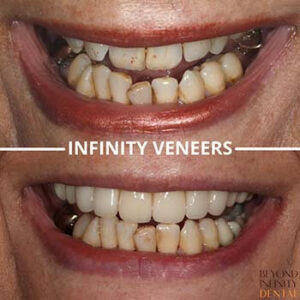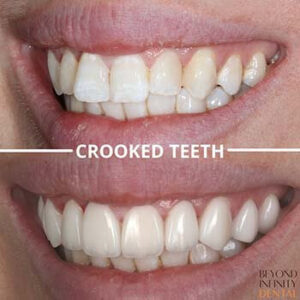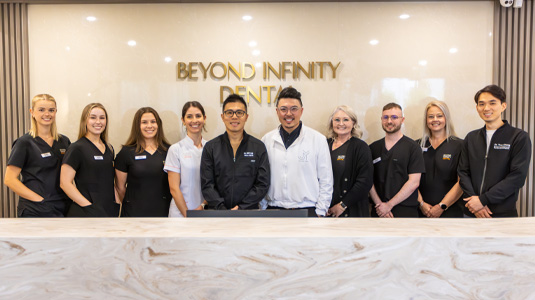If your teeth are overlapping or crooked you may think that the only solution is some form of orthodontic treatment. While in some cases this is likely to be true, in other cases, porcelain veneers can correct the appearance of crooked teeth to give the illusion of a perfectly straight smile.
One of the questions that we’re often asked as dentists is “can I get dental veneers if I have crooked teeth or do I need to wear braces?”
This is a good question and one that can only be answered with a personal assessment from our highly experienced cosmetic dentist, Dr Jack Yang.
You see, porcelain veneers sit beneath the umbrella of cosmetic dentistry. In other words, they are a cosmetic choice, a bit like purchasing alloy wheels for your car or getting your eyebrows waxed. So while they can’t actually straighten crooked teeth, veneers can give the cosmetic appearance of a straighter healthier smile.
So what’s it to be – braces or veneers for crooked teeth?
If your teeth are severely crooked or misaligned it’s highly likely that we would recommend braces or Invisalign as a more viable option and maybe look at dental veneers at a later date once your teeth are straighter.
On the other hand, some patients even though they have straight teeth dislike the shape, size and colour of their teeth and therefore will turn to dental veneers to correct these imperfections,
At the end of the day, we make recommendations and patients ultimately make their own decisions.
Either way, here’s what you need to know…
 Whether you have multiple porcelain veneers to correct the crooked teeth in your smile line or you pick out individual teeth that you dislike the look of, an element of tooth preparation will be required.
Whether you have multiple porcelain veneers to correct the crooked teeth in your smile line or you pick out individual teeth that you dislike the look of, an element of tooth preparation will be required.
For this reason, it’s important to understand that in most cases dental veneers treatment is an irreversible process – Meaning once you have them, you will always need to wear them.
Even if very little or no shaving of the enamel is required, the surface of the enamel will be slightly roughened to bond the dental veneer to the tooth.
Composite dental veneers, on the other hand, require very little if any preparation and can usually be reversed if done well. However, the downside is that they typically last a fraction of the time. 5-7 years on average as opposed to 15-20 for porcelain veneers.
Be sure to do your research before rushing into a decision
The key thing before you rush into any treatments is to ensure you understand all the teeth straightening options before having porcelain veneers applied to your teeth. After all, they are to all intent and purpose permanent and depending on how many you need, they can represent a significant monetary investment.
Read on to learn more about the process of dental veneers for crooked teeth
Dental veneers are thin coverings or shells made from porcelain or types of composite materials. When placed over the front surface of the teeth they can dramatically alter the appearance of slightly crooked teeth, concealing flaws and imperfections to create a beautifully even white smile.
Each veneer is customised to fit each tooth and coloured to match the shade of the surrounding teeth, so they blend seamlessly into the smile.
Porcelain veneers in particular look incredibly lifelike because porcelain has a similar translucency and sparkle to tooth enamel. When well-executed, they resemble enhanced or better versions of your natural teeth.
Furthermore, porcelain veneers can improve the shape and look of your smile by changing the position and appearance of your teeth – closing gaps, making small teeth appear larger, and fixing any ‘pointy’ teeth to make your entire smile more symmetrical.
If your teeth are deeply stained or grey from a previous injury or medications, dental veneers can even fix that.
Craters, bulges or uneven surfaces and jagged tooth edges can all be smoothed over with tooth veneers.
Ultimately, veneers are an ideal option for an individual who doesn’t have extensive tooth damage but would like to perfect their smile in a relatively minimally invasive way.
Veneers for crooked teeth – How do they work?
Veneers work by covering the front surface of the tooth with a wafer-thin layer of porcelain or composite resin (the same material used for white tooth fillings). A small layer of enamel has to be removed to ensure that when the veneer is placed, it maintains the same thickness as the real tooth. This is so that it sits flush within the smile.
 Not every tooth has to be covered, just the ones that are causing a problem and possibly the neighbouring teeth.
Not every tooth has to be covered, just the ones that are causing a problem and possibly the neighbouring teeth.
Here at Beyond Infinity Dental, we use digital smile design software which enables us to involve patients from the get-go. By giving them an on-screen view of how their new smile will look, patients find it easier to visualise and communicate their desired outcome.
Most patients choose to veneer just the front teeth (top, bottom or both) since these are the teeth that most people see.
And, in many cases, we can achieve a similar effect with composite veneers/bonding which costs less but are not as durable.
What are the main advantages of tooth veneers?
The main advantage of porcelain veneers is that they can be adjusted as your face alters with age. They’re also completely customisable, so it’s likely that you can achieve your dream, natural-looking smile without too much hassle.
Another advantage of tooth veneers is that they can be completed in just 2 dental appointments whereas braces or aligners would take months to make the same sort of adjustments. This makes dental veneers the perfect choice for anyone wanting a quick cosmetic solution for their crooked teeth.
If you’re unhappy with the appearance of your smile and would like to learn more about dental veneers for crooked teeth and other dental issues, why not schedule a consultation with Dr Yang at Beyond Infinity Dental. He has a wealth of experience and will be happy to discuss alternative dental treatments so that you can make an informed decision. Call us now on (02) 8806 3799.
Note: Any surgical or invasive procedure carries risks. Before proceeding, you should seek a second opinion from an appropriately qualified health practitioner.










